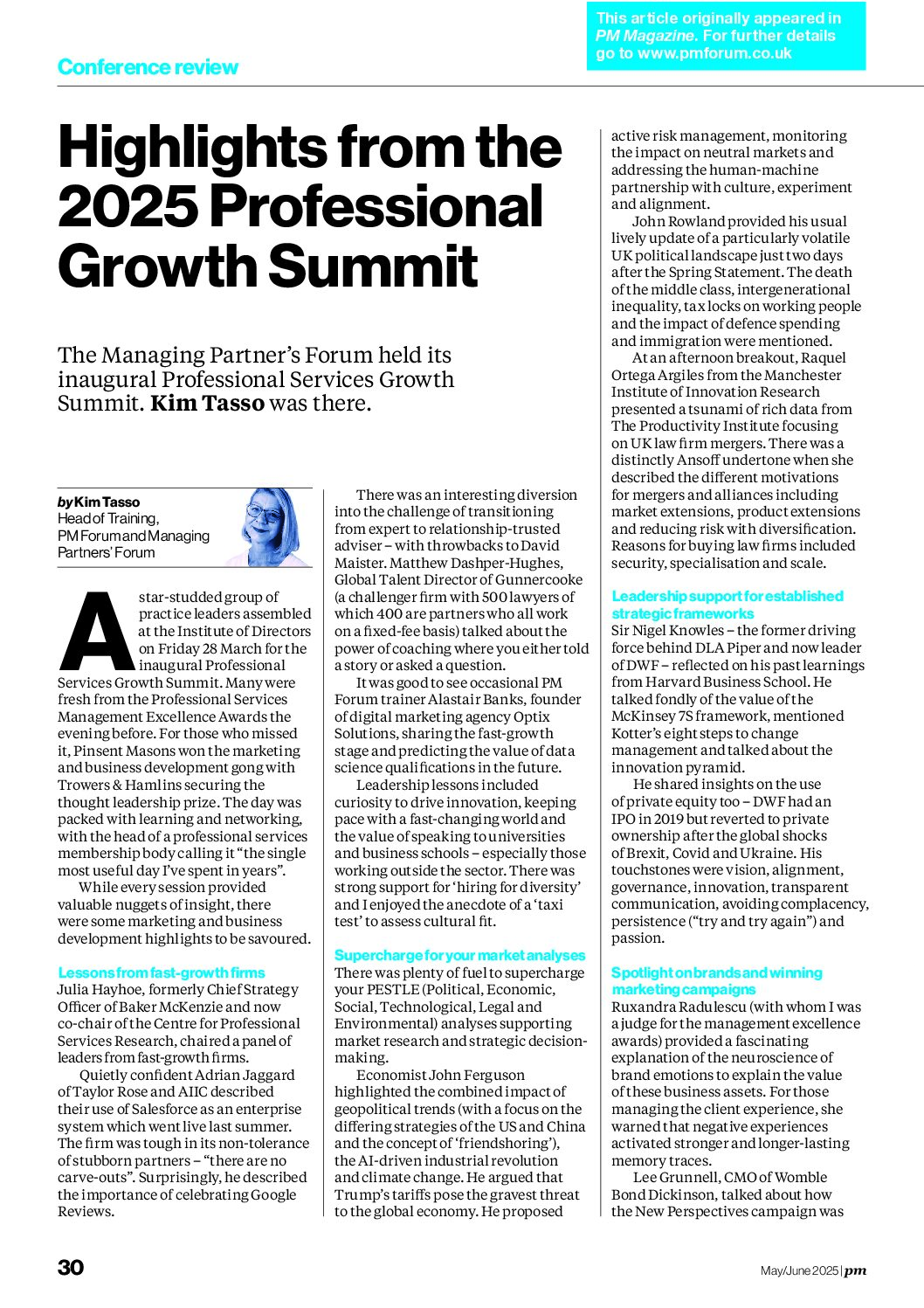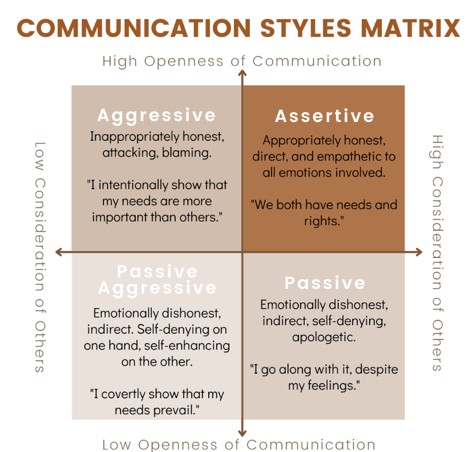
I’m frequently asked to help with the challenge of how to design a marketing and business development team in professional service firms that is fit for the future. I have developed a consultancy methodology for doing so. I recently used it to talk through the process with the director of a large professional services marketing team and his verdict was that it was a useful framework. I’ve summarised the key elements.
Team of today vs. team of tomorrow? Start with a blank sheet
We rarely start with a blank sheet. There are usually staff deployed in various functions in an existing team. However, you need to start with a blank sheet mentally to identify the sort of marketing and business development team that your firm needs for the future first. Work towards a Target Operating Model (TOM) – the desired state of the operations of a business. Then you can work out how to transition your existing people and recruit new members to reach the desired team of the future.
External influences
Economy and global influences
Some firms will have separate teams of business analysts and researchers focused on analysing major trends in the market that will affect the business, its markets and its clients. This is particularly so in the property sector. In some firms, this research drives the strategic planning through scenario analysis.
However, in other firms this role is left to the marketing and business development team whether using external research resources, commercial online services or seconded fee-earners. How will you manage external research and analysis?
Many firms have global operations. Some will have global and regional strategies. So will marketing and business development be managed globally or distributed so that each territory has autonomy in some or all of its operations?
Competitors
There is a significant amount of disruption and consolidation taking place in all professional services markets – legal, accountancy and property. New entrants arrive regularly. More are to come. This means that firms may need to make radical changes to their business model – and thus the marketing and business development team as well.
As markets march further onto on-line platforms the nature of the markets they serve and the way they develop and deliver services can change too. So all aspects of the marketing and business development strategy can be affected. So who’s monitoring competitor activity – on a global, local and sector basis?
Technology developments
Technology will have an impact on the design of your team in a number of ways. Obviously, there will be an impact on your market and clients and even your firm’s products and services. Sometimes this is driven by the fee-earners and sometimes by knowledge professionals. Who’s managing the design and delivery of new products and services in your firm?
But marketing automation and technology is moving rapidly too. There are an increasing number of systems and tools that enable marketing to be systemised and automated. Some of these may mean that those outside the marketing and business development team – whether fee-earners or other support staff – can take over activities previously managed by the team. Who is driving and managing the use of marketing automation?
Digital marketing is moving at a rapid pace as well – with new tools and channels taking over or enhancing existing methods. You will need an understanding of these technologies to assess the extent to which they might supplant or support members of the marketing team and to consider any new digital skill sets that might be needed. Do you integrate digital marketing or deploy a separate team?
Internal influences
Business strategy and plan
A natural starting point internally is to consider what the firm aims to achieve over the next three to five years. It may be that the firm intends to acquire other businesses, restructure its divisions, enter new markets, open new offices, launch new products and services or expand some elements of the business faster than others. The future shape of the firm is the initial input into your thoughts about the shape of your future marketing and business development team as the team.
Marketing strategy and plan
The marketing strategy translates how the business plan will be achieved at the “corporate” level. There also needs to be marketing and business development plans for each market and service line. And maybe for critical campaigns and initiatives.
It needs to be clear who is responsible for creating these plans (and generating the data and information that is required to do so) and for managing their implementation.
The marketing and business development objectives will indicate how the firm will measure the effectiveness of its marketing and business development operations. So any team must be aligned to supporting them.
Markets or services or matrix?
This has an important impact on the structure of the marketing and business development team. Which “theatres” are reflected in the structure of the business – is it by geography or territory, by market sector or by service line or practice group? In many firms, there is a matrix approach with marketing and business development staff being allocated to markets, services and offices – and even a combination.
Internal influences spectrum
There are a number of factors on what I call the “internal influences spectrum” that will have an impact on how you design your marketing and business development team. Whilst it might be desirable to design a state-of-the-art marketing and business development team, if it doesn’t fit within or adapt to these internal influences it is unlikely to be successful. For example:
- Organisational culture
- Is the firm centralised or decentralised? And should the marketing and business development team emulate the predominant structure? While the value of having business development people embedded with the fee-earners in their respective teams, there is also value in having some specific functional services in an efficient central team. Some adopt a hub and spoke approach – where requests are received and assessed centrally (a sort of triage) and then allocated to those with the relevant skills and capacity.
- Service orientation
- Is market/business development seen primarily as a proactive driver of the business or a reactive provider of services? In some firms, marketing and business development drives strategy and takes a leading role in identifying new initiatives and making them happen. In other firms, it is a reactive provider of expertise and support services.
- Qualification and skill level
- Does the firm value professional marketing qualifications and high levels of skill in the team? Many firms will appreciate the value of high calibre, qualified and experienced marketing and business development personnel. Whilst in other firms, they prefer people to be hands-on operational pragmatists which is fine – although the link to strategy and commercial results may need extra attention.
- Client contact
- To what extent does the marketing and business development team have direct client contact or are they operating very much in the back office? Some firms have business development people who take on account management, sales and client listening activities that put them in the frontline of client contact. The level of commercial and technical knowledge (product knowledge) will be important. Many firms now employ lawyers, accountants and surveyors in business development roles for this reason.
- Client concentration
- Does the firm have a few very large clients or a large number of smaller clients? Again, the nature of the marketing and business development task will differ depending on the client concentration. In some firms there are separate teams for generating new business and managing existing client and referrer relationships
- Level of automation
- Some marketing and business development teams enjoy a high degree of automation and digitization, with many systems to provide the relevant information and support to enable them to do their work quickly and efficiently. Other teams are more constrained because the marketing infrastructure – whether in terms of client databases, client and financial analysis, content management, digital asset management, social media management and campaign or event management – is underdeveloped and so significant time is invested in developing such resources.
- Budget
- Some firms will support investment in new members of staff whereas others may prefer to limit head count and rely on external resources, part-time contracts and other methods of outsourcing marketing and business development expertise. Some firms will require flexibility – ensuring that staff have a range of skills and can be deployed in a variety of different situations and tasks. Some firms have marketing and business development teams that are primarily account managers – who take the brief and pull in the required external resources as required – or project managers who are able to apply their skills in a variety of marketing and business development situations.
Business development functions
Business development broadly comprises three main functions – marketing, selling and relationship management. Each firm – and indeed each market or service group or office – is likely to have a different emphasis on them. Their position in the market and strategies will determine the extent to which they are reliant on marketing.
Broadly speaking, larger firms will have more emphasis on relationship management and smaller firms will be more focused on selling. Transactional business is likely to have a different combination to a predominantly relationship business and there is also likely to be some change depending on the mix of B2B (Business to Business) and B2C (Business to Consumer) activities.
However, when designing your marketing and business development team you need to consider the following functions:
- Strategic Marketing
- Development of marketing strategy and plans
- Policy and process management
- Market and other research
- Innovation and new product or service development
- Segmentation and positioning
- New market entry and development
- Pricing
- Campaign development
- Tactical Marketing (Marketing Communications)
- Brand management
- Campaign and project management
- Public Relations including internal communications
- Web site management
- Content management
- Digital marketing and channel management
- Social media management
- Lead generation
- Sales and selling
- Targeting and research
- Pipeline and opportunity management
- Contact management
- Proposition development
- Sales management
- Telemarketing
- Pitch and tender management
- Negotiating and contracting
- Training and coaching
- Relationship or account management
- Quality and service delivery
- Client service management
- Client satisfaction monitoring
- Client or account planning
- Referrer management
- Key Account Management (KAM)
Specialist functions
In addition to these business development activities, there is likely to be a number of specialist functions which may be best located centrally or outsourced to specialist agencies for efficiency purposes. For example:
- Creative
- Design
- Copywriting
- Photography and image management
- Video production
- Analytic
- Research and market analysis
- Financial analysis
- Budgeting and reporting
- Data mining (big data)
- Operational
- Event management
- Project management
- Systems analysis
- Technology solutions (e.g. App development)
Ultimately, your marketing and business development team must be fit for purpose. Sophisticated firms will measure effectiveness based on the extent to which the marketing and business development resources meet the agreed objectives and deliver the required return on investment (ROI) or return on marketing investment (ROMI).
Yet in other firms, the marketing and business development team will be assessed on the basis of the extent to which it serves the needs of its partners and fee-earners.
Join the debate?
One of the marketing/business development directors I have worked with in this area is keen to arrange and host a small, informal workshop for other directors to discuss the topic. Please let me know kim@kimtasso.com if you would like me to put you in touch with him so that you can be invited.
Related posts
marketing case study – Clark Hill redesigns its marketing and BD team (kimtasso.com)
Recruiting and retaining marketing and business development (kimtasso.com)
Proactive Marketing Executive – Plans, Budgets, Relationships and Career (kimtasso.com)
How to advance your career in professional services marketing (kimtasso.com)
become a more proactive Marketing and Business Development Executive (kimtasso.com)
For details of training workshops for M&BD assistants, executives and managers please see PM Forum









